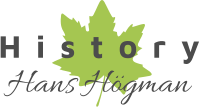

Copyright © Hans Högman 2021-07-24


Owner’s Marks -
Sweden
Owner’s Marks in Medelpad,
Sweden
In the past, when knowledge and the ability to read
and write were not so great, owner's marks (Swe:
bomärken) were used as signs to recognize and
indicate what was owned by a family or farm.
Owner's marks were used on both movable and
immovable property.
The owner's marks were a recognized symbol and
were used above all as a mark for the farm and its
movable property, such as tools and household
utensils. An example of use for the immovable
property was the use of the owner’s mark as a
farmland boundary mark (landmark) and as a farm
symbol in the rural community.
The mark was designed so that it would be easy to
carve or cut into what was to be marked. Usually, it
was straight lines or arcs. The resemblance to the
runes was great.
The owner's mark belonging to a farm was
inherited and could remain unchanged for several
generations. When a new owner's mark was
created, it was usually at homestead distributions
due to inheritance. The new owner's mark was
often only slightly modified, often with the addition
of a line.
The owner's mark was the holder's and family's
special property mark for their home and an
expression of fellowship and work efforts within
the parish and village councils. Participation and
order of precedence were often marked by the
owner’s mark in the fiery cross (budkavle), and the
hammer, etc.
Ownership and use of owner's marks were
regulated in Medelpad province in the Hälsingland
Law's Village Council Code “Hälsingelagens
Byalagsbalk”. This law was taken down in the early
14th century. The system of owner's marks applied
to all social classes.
During the 16th century, the owner's marks of
clergy and officials usually had a heraldic design in
the form of a seal (sigill). Company logos also have
their origins in the owner's marks.
As written marks became more common, using
quills and ink, the owner's marks changed to make
it easier and faster to write them in pen. They
became more "rounded" instead of angular. They
became more and more like letters, initials.
The old owner's marks gradually disappeared in
the 19th century as literacy became more
widespread.
Below are some examples of owner's marks used
by my ancestors in Ljustorp and Hässjö parishes,
Medelpad (Y).
Examples of Owner’s Marks
from Ljustorp Parish, Medelpad
(Y)
This owner's mark has been used by my ancestors
on the farm Öppom nr 2 in Ljustorp.
At least three generations on the male line have
used this mark:
Pehr Jonsson (1660-1725), his son Erik
Pehrsson (1704-1767) and his grandson
Pehr Ersson (1730-1816).
The mark has been used on the farm
Lövberg nr 1 in Ljustorp. Holder Anders
Olsson (1668-1747) and his son Lars
Andersson (1731-1800).
The mark has been used on the farm
Lövberg nr 2 in Ljustorp. Holder Olov
Andersson (1715-1791). Olov and Lars at
Lövberg 1 above were siblings.
The mark has been used on the farm
Björkom nr 4 in Ljustorp. Holder Erik
Nilsson (1705-1800).
The mark has been used on the farm Edsta
nr 2 in Ljustorp. Holder Augustin Nilsson
(16..-1710) and grandson Isak Nilsson (1699-
1771).
The mark has been used on the farm
Hamre nr 2 in Ljustorp. Holder Anders
Olsson (1657-1719) and his son Lars
Andersson.
Märket har använts på gården Högland nr
1 i Ljustorp. Innehavare Ingemar Olsson.
Står som ägare till gården år 1620.
The mark has been used on the farm
Högland nr 4 in Ljustorp. Holder Olov
Davidsson (1654-1693).
The mark has been used on the farm
Jällvik nr 2 in Ljustorp. Holder Erik Jonsson
(1691-1765).
Example of an Owner’s Mark from
Hässjö Parish, Medelpad (Y)
The mark has been used on the farm
Västanbäck nr 1 in Hässjö. Holder Anders
Thomasson (1755-1815).













































